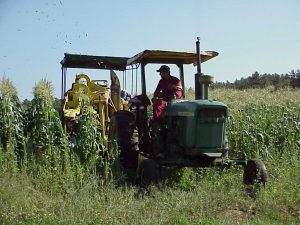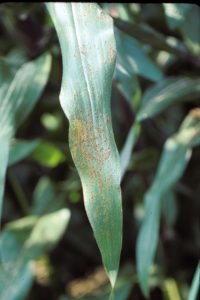Sweet Corn IPM Newsletter No. 10 — September 1, 2023
MOTH COUNTS LOWER THIS WEEK
Most Fresh Silking Corn Still Requires Protection
SITUATION

Cool night temperatures appear to have slowed corn pest activity this week as moth counts were lower at most locations. Growers are looking forward to a strong market for the holiday weekend, and supply and quality are looking good, in spite of more showers and wet conditions.
European corn borer: Some locations appear to be experiencing a late second generation of European corn borer. The greatest risk at this point in the season is that these moths will lay eggs on or near the ears and the larvae will move directly into the ears after hatching. Moth counts were over the 5-moth/week threshold for silking corn in Biddeford and Dayton this week.
Corn earworm: Moth counts were lower in most locations this week, probably due to cooler night temperatures. Based on this week’s moth counts, a 4-day spray interval for silking corn was recommended for Bowdoin, Cape Elizabeth, Dayton, Monmouth, New Gloucester, Wayne and Wells. A 5-day spray schedule was recommended for Auburn, Biddeford and Oxford. A 6-day spray interval was recommended for Lewiston. Once the silks have dried, corn earworm is unlikely to lay eggs on the ears, so sprays should be targeted for corn in the fresh, green silk stage.
Fall armyworm: Moth counts continue to be low at most locations. Only the New Gloucester site was over the three-moth threshold for silking corn. Larval feeding was noted in a few fields, but infestations have been light, and as the fields come into silk, sprays for corn earworm should also provide control of fall armyworm.
Western Bean Cutworm: Moth numbers were generally low this week, suggesting that this pest may no longer be a threat in most locations for the remainder of the season. Populations of this pest tend to drop off very rapidly toward the end of August.

Corn rust: I have seen corn rust in several fields this week. Rust is a fungus disease that causes reddish-brown pustules to form on the leaves and husks, reducing the quality of the ears. Typically, corn rust does not become a problem until late in the season. A fungicide spray for rust would only be recommended if the infection were noticed in a field prior to tasseling. Later infections are unlikely to cause enough damage to the crop to justify control measures. Materials available to control corn rust include Quadris, Bravo®, and Quilt®.
There’s still time for cover crops!
Plowing down corn stalks and stubble is an important means of managing European corn borer by destroying their over wintering sites. However, plowing can leave soil exposed and prone to erosion during the winter. Oats can be planted into late August and winter rye can be planted well into September and still produce enough of a cover to prevent erosion. Oats will winter kill. Rye will survive the winter and put on more growth in the early spring. This may delay spring planting, as you must wait for conditions to be warm and dry enough to plow it in.
Sincerely,
David T. Handley
Vegetable & Small Fruit Specialist
Highmoor Farm
P.O. Box 179
52 U.S. Route 202
Monmouth, ME 04259
207.933.2100
UMaine Extension Diagnostic Research Lab
Pest Management Unit
17 Godfrey Drive
Orono, ME 04473
1.800.287.0279
| Location | CEW Moths | ECB Moths | FAW Moths | %Feeding Damage | Recommendations / Comments |
|---|---|---|---|---|---|
| Auburn | 6 | 1 | 0 | — | 5-day interval recommended for silking corn |
| Biddeford | 5 | 5 | 1 | — | 5-day interval recommended for silking corn |
| Bowdoinham | 15 | 2 | 0 | — | 4-day interval recommended for silking corn |
| Cape Elizabeth | 30 | 3 | 1 | — | 4-day interval recommended for silking corn |
| Corinth | 22 | 2 | 4 | 3% | 4-day interval recommended for silking corn |
| Dayton | 30 | 25 | 1 | — | 4-day interval recommended for silking corn |
| Farmington | 0 | 0 | 2 | — | No spray recommended |
| Hollis | 1 | 0 | 0 | — | No spray recommended |
| Lewiston | 3 | 0 | 0 | — | 6-day interval recommended for silking corn |
| Monmouth | 19 | 0 | 2 | — | 4-day interval recommended for silking corn |
| New Gloucester | 13 | 0 | 17 | — | 4-day interval recommended for silking corn |
| Oxford | 7 | 2 | 1 | — | 5-day interval recommended for silking corn |
| Palmyra | 1 | 1 | 0 | — | No spray recommended |
| Wayne | 15 | 1 | 1 | — | 4-day interval recommended for silking corn |
| Wells I | 19 | 0 | 2 | — | 4-day interval recommended for silking corn |
| Wells II | 17 | 1 | 1 | — | 4-day interval recommended for silking corn |
CEW: Corn earworm (Only fresh silking corn should be sprayed for this insect.)
ECB: European corn borer
FAW: Fall armyworm
| Moths caught per week | Moths caught per night | Spray Interval |
|---|---|---|
| 0.0 to 1.4 | 0.0 to 0.2 | No spray |
| 1.5 to 3.5 | 0.3 to 0.5 | Spray every 6 days |
| 3.6 to 7.0 | 0.6 to 1.0 | Spray every 5 days |
| 7.1 to 91 | 1.1 to 13.0 | Spray every 4 days |
| More than 91 | More than 13 | Spray every 3 days |
Thresholds apply only to corn with exposed fresh silk. Lengthen spray intervals by one day if maximum daily temperature is less than 80°F.
European Corn Borer Thresholds
Whorl stage: 30% or more of plants scouted show injury.
Pre-tassel-silk: 15% or more of plants scouted show injury.
Silk: 5 or more moths caught in pheromone traps in one week.
IPM Web Pages:
Explore Integrated Pest Management in Maine — UMaine
Integrated Pest Management Data Visualization Tool — Penn State
Integrated Pest Management — UMass Amherst
Where brand names or company names are used, it is for the reader’s information. No endorsement is implied nor is any discrimination intended against other products with similar ingredients. Always consult product labels for rates, application instructions and safety precautions. Users of these products assume all associated risks.
In complying with the letter and spirit of applicable laws and pursuing its own goals of diversity, the University of Maine System does not discriminate on the grounds of race, color, religion, sex, sexual orientation, transgender status, gender, gender identity or expression, ethnicity, national origin, citizenship status, familial status, ancestry, age, disability physical or mental, genetic information, or veterans or military status in employment, education, and all other programs and activities. The University provides reasonable accommodations to qualified individuals with disabilities upon request. The following person has been designated to handle inquiries regarding non-discrimination policies: Director of Equal Opportunity, 5713 Chadbourne Hall, Room 412, University of Maine, Orono, ME 04469-5713, 207.581.1226, TTY 711 (Maine Relay System).
